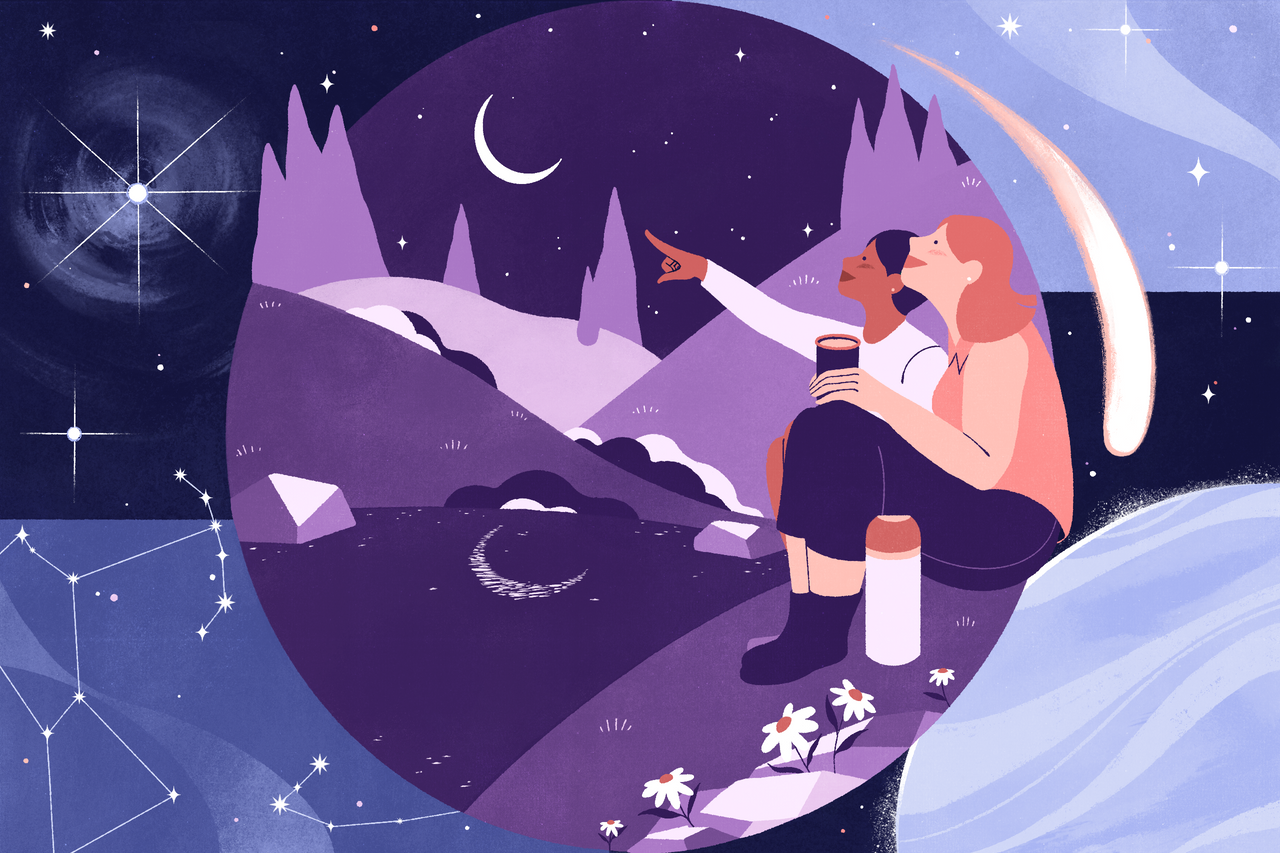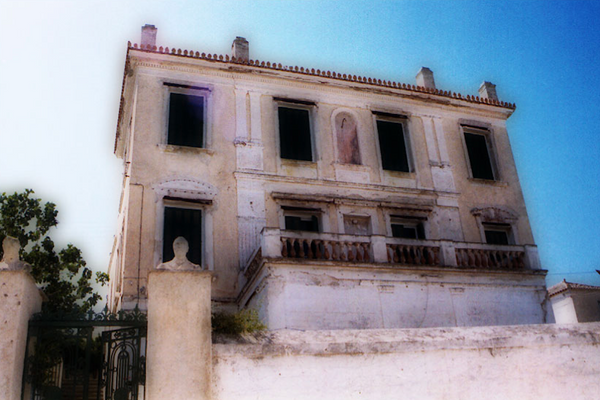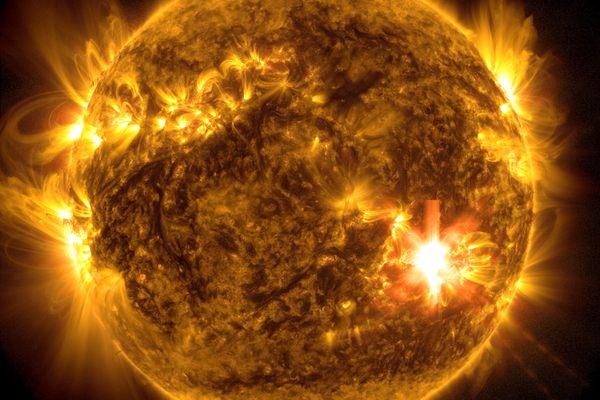In October, Our Night Sky Is Full of Scary Stories
Stargazers in the Northern Hemisphere can find the demon star Algol, a murdered monster, and victims of vengeful gods.
Atlas Obscura’s Wondersky columnist Rebecca Boyle is an award-winning science journalist and author of the upcoming Our Moon: How Earth’s Celestial Companion Transformed the Planet, Guided Evolution, and Made Us Who We Are (January 2024, Random House). She regularly shares the stories and secrets of our wondrous night sky.
Once upon a time, Orion, a masterful hunter, boasted that he could kill all the animals of Earth if he wanted. Horrified, the Earth goddess Gaia had him murdered by a scorpion. But other gods and goddesses mourned the mighty hunter and asked for him to be placed in the sky, a great honor. Ever since, he and deadly Scorpio are always found 180 degrees apart; late autumn is the best time of year to see Orion as he crests the eastern sky in the evening.
Higher up in the sky, toward the north, look for the stars that form the letter “W.” This is the reclined figure of the vain queen Cassiopeia, who claimed that she and her daughter were more beautiful than the gods—and paid the ultimate price for her hubris.

Stargazing is a calming, even meditative hobby, but the constellations we enjoy in our nocturnal contemplation represent some of our most violent myths. Spooky season is a great time to learn some of the more bizarre stories. Take, for example, these classic tales from ancient Greece.
(And by the way, while many cultures have their own equally complex stories about the stars, we can thank astronomer Claudius Ptolemy for the persistence of Greek legends in how the stars are named and organized in Western tradition. In the second century, Ptolemy named many constellations in his mathematical treatise The Almagest, which would influence astronomy for more than a millennium.)

Back to our night sky: Between Cassiopeia and Orion, the hero Perseus holds the severed head of Medusa. The slain gorgon’s eye, marked by the “demon star” Algol, blinks every three days. Legend says that anyone who looks directly at it will turn to stone. In reality, Algol is a binary star system. As its two stars orbit each other, one of them disappears behind the other; this is what creates the dimming and brightening effect, the demon winking at you.
North of Perseus, the constellation Cassiopeia is a W or an M, depending on the time of year. And the story of this shape contains one of the cruelest legends in antiquity’s treasure chest of woe. She was a queen of a northern African nation along the upper Nile, married to King Cepheus. In some versions, Cassiopeia’s mother was a goddess, but one thing all sources agree on: Cassiopeia and her daughter, Andromeda, were very beautiful, and the queen enjoyed saying so. The gods were offended that she, a mortal, would dare compare herself to them. When the queen suggested that she and Andromeda rivaled the sea nymph daughters of the god Nereus, Poseidon decided to punish mother and daughter—and their people. He unleashed great floods upon northern Africa. King Cepheus and Queen Cassiopeia consulted an oracle for help, and were told they could save their lands if they sacrificed their daughter. So they had her chained to a rock, consigned to being eaten by a sea monster, Cetus.
Perseus, meanwhile, was returning from his successful assassination of the snake-haired gorgon Medusa. He heard of Andromeda’s beauty and decided to investigate. He arrived in the nick of time, managing to use Medusa’s severed head to kill Cetus. Perseus fell madly in love with Andromeda, and they shared a happy ending—they got married and had nine children. At the end of their lives, the goddess Athena placed Perseus and Andromeda in the sky. Their final resting place was not far from Andromeda’s mother, whose position is somewhat less graceful.

Poseidon put Cassiopeia on a throne that circles high overhead, so that half the year, her throne hangs upside down, forcing her to hold on lest she fall off. Her position serves as a reminder that mortals should never claim to be greater than the gods—and, I prefer to think, that there is no greater evil than to sacrifice one’s own children to save yourself.
Near Cassiopeia but closer to the horizon, you can find Orion: He rises a couple hours after sunset beginning late this month, which is also, in the Northern Hemisphere, the time of the hunter. It’s literally hunting season in the American West, where I live; it is also the time of the Hunter’s Moon, rising full on Oct. 28.
Orion is one of the most recognizable constellations, with his three-starred belt and the bright, dying star Betelgeuse marking his right shoulder. To find Orion, look to the east in the late evening; depending on how far north you are located, he might not rise until after 10 p.m. One legend has it that Artemis, goddess of the Moon and the hunt, put him there.
In the version of his story that I shared earlier, Zeus’s wife Hera sent a scorpion to kill Orion. In another telling, Orion and Artemis are lovers, but Apollo, the brother of Artemis, became jealous, and tricked her into shooting Orion with her bow. In the Odyssey, his ghost hangs out in the underworld, where Odysseus sees him using a bronze club. To this day, some star maps that include overlay illustrations of the constellations depict Orion with that club in his raised right arm.
A slain hunter, vengeful gods, a selfish mother, a murdered monster … spooky season is a good time to remember that while the night sky is peaceful, it is also dark, and full of terrors.
Is there something you’d like to know about our brilliant night sky? Share your stargazing questions with us and you may see them answered in a future Wondersky column!











Follow us on Twitter to get the latest on the world's hidden wonders.
Like us on Facebook to get the latest on the world's hidden wonders.
Follow us on Twitter Like us on Facebook